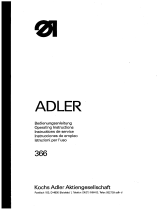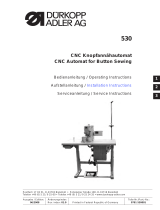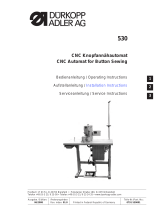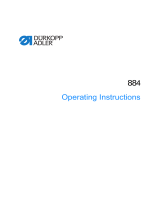Page is loading ...

531
CNC Knopfannähautomat
CNC Automat for Button Sewing
Bedienanleitung / Operating Instructions
Aufstellanleitung / Installation Instructions
Serviceanleitung / Service Instructions
Postfach 17 03 51, D-33703 Bielefeld Potsdame r Straße 190, D-33719 Bie lefeld
Telefon +49 (0) 5 21/ 9 25-00 Telefa x +49 (0) 5 21/ 9 25 24 35 www.duerkopp-adler.com
1
2
3
Ausgabe / Edition: Änderungsindex Teile-Nr. /Part.-No.:
02/2011 Rev. index: 01.0 Printed in Federal Republic of Germany 0791 531001

Alle Rechte vorbehalten.
Eigentum de r Dürkopp Adler AG und urheberrechtlich geschützt. Jede, auch auszugsweise
Wiederverwendung dieser Inhalte ist ohne vorheriges schriftliches Einverständnis der Dürkopp Adler AG
verboten.
All rights reser ved.
Property of Dürkopp Adler AG and copyrighted. R eproduction or publication of the content in any
manner, even in extracts, without prior written permission of Dürkopp Adler AG, is prohibited.
Copyright ©
Dürkopp Adler AG - 2011

Foreword
This instruction manual is intended to help the user to become familiar
with the machine and take advantage of its application possibilities in
accordance with the recommendations.
The instruction manual contains important information on how to
operate the machine securely, properly and economically. Observation
of the instructions eliminates danger, reduces costs for repair and
down-times, and increases the reliability and life of the machine.
The instruction manual is intended to complement existing national
accident prevention and environment protection regulations.
The instruction manual must always be available at the machine/sewing
unit.
The instruction manual must be read and applied by any person that is
authorized to work on the machine/sewing unit. This means:
– Operation, including equipping, troubleshooting during the work
cycle, removing of fabric waste,
– Service (maintenance, inspection, repair) and/or
– Transport.
The user also has to assure that only authorized personnel work on the
machine.
The user is obliged to check the machine at least once per shift for
apparent damages and to immediatly report any changes (including the
performance in service), which impair the safety.
The user company must ensure that the machine is only operated in
perfect working order.
Never remove or disable any safety devices.
If safety devices need to be removed for equipping, repairing or
maintaining, the safety devices must be remounted directly after
completion of the maintenance and repair work.
Unauthorized modification of the machine rules out liability of the
manufacturer for damage resulting from this.
Observe all safety and danger recommendations on the machine/unit!
The yellow-and-black striped surfaces designate permanend danger
areas, eg danger of squashing, cutting, shearing or collision.
Besides the recommendations in this instruction manual also observe
the general safety and accident prevention regulations!

General safety instructions
The non-observance of the following safety instructions can cause
bodily injuries or damages to the machine.
1. The machine must only be commissioned in full knowledge of the
instruction book and operated by persons with appropriate training.
2. Before putting into service also read the safety rules and
instructions of the motor supplier.
3. The machine must be used only for the purpose intended. Use of
the machine without the safety devices is not permitted. Observe all
the relevant safety regulations.
4. When gauge parts are exchanged (e.g. needle, presser foot, needle
plate, feed dog and bobbin) when threading, when the workplace is
left, and during service work, the machine must be disconnected
from the mains by switching off the master switch or disconnecting
the mains plug.
5. Daily servicing work must be carried out only by appropriately
trained persons.
6. Repairs, conversion and special maintenance work must only be
carried out by technicians or persons with appropriate training.
7. For service or repair work on pneumatic systems, disconnect the
machine from the compressed air supply system (max. 7-10 bar).
Before disconnecting, reduce the pressure of the maintenance unit.
Exceptions to this are only adjustments and functions checks made
by appropriately trained technicians.
8. Work on the electrical equipment must be carried out only by
electricians or appropriately trained persons.
9. Work on parts and systems under electric current is not permitted,
except as specified in regulations DIN VDE 0105.
10. Conversion or changes to the machine must be authorized by us
and made only in adherence to all safety regulations.
11. For repairs, only replacement parts approved by us must be used.
12. Commissioning of the sewing head is prohibited until such time as
the entire sewing unit is found to comply with EC directives.
13. The line cord should be equipped with a country-specific mains
plug. This work must be carried out by appropriately trained
technicians (see paragraph 8).
It is absolutely necessary to respect the safety
instructions marked by these signs.
Danger of bodily injuries !
Please note also the general safety instructions.

Contents Page:
Part 2: Installation Instructions Class 531 - Original instructions
1 Scope of delivery .............................................. 3
2 General and transport safety devices ................................. 3
3 Installing the support frame and the control cabinet
3.1 Tableplates.................................................. 5
3.2 Fittingthesupportingframeparts..................................... 5
3.3 Completingthetableplate......................................... 6
3.4 Connectingthecontrolboxtothemainswitch............................. 7
3.5 Fittingthereferencevaluetransmitterandthepotentialequaliser................. 8
3.6 Adjustingtheworkingheight........................................ 9
4 Fitting the button sewer
4.1 Fittingtheoilsump.............................................. 10
4.2 Attachingthebuttonbuttonsewer.................................... 11
4.3 Fittingtheoillines.............................................. 12
4.4 Fittingtheoperatingpanel......................................... 12
4.5 Fittingtheprotectivecover......................................... 13
5 Connecting the plug connections to the control box
5.1 Plugconnectionsonthecontrolbox................................... 14
5.2 Layingcables................................................. 15
6 Changing sewing feet and the material support plate ...................... 16
7 Fitting eye guard .............................................. 17
8 Oil lubrication
8.1 Filling with oil ................................................. 18
8.2 Lubricatingthewicksandfeltpart(connectingrod) ......................... 19
8.3 Lubricatingtheshuttlerace........................................ 20
9 Commissioning
9.1 Seriesdelivery ................................................ 20
10 Installing t he machine software
10.1 General..................................................... 21
10.2 Loadingtheprogram............................................. 22
10.3 Dongle update via the Inter net....................................... 24
11 Sewing test .................................................. 25
12 Additional e quipment
12.1 Sewinglight.................................................. 26
2

1
3
9
8
7
6
2
5
4

2
1 Scope of delivery
The scope of delivery depends on your order.
Please check that all necessary parts are there before installing.
This description applies to a button sewer whose individual
components are supplied complete by Dürkopp Adler AG.
–
1 Top part including oil bath
Electrical parts set with:
–
2 Control panel
–
5 Mains sw itch
–
6 DAC control unit
Dürkopp-Adler accessories kit with:
–
3 Thread stand
–
Protective cover (not illustrated)
–
8 Supporting frame (optional)
–
7 Pedal and connecting rod (optional)
–
4 Table plate (optional)
–
9 Drawer (optional)
2 General and transport safety devices
CAUTION!
The button sewer may only be operated by qualified staff.
Securing devices for transport
If you have bought a detachable button sewer the following transport
safety devices must be removed:
–
Retaining bands and wooden strips on the t op of the machine,
table and supporting frame.
3

Centre punching on the bottom
1 x only in this place
4 Centre punching for
spax screws
4

5
2
3 Fitting the supporting frame and control cabinet
3.1 Table plates
The cutouts on the table plates you have made yourself must be the
size specified in the diagram.
Caution, danger of injury!
The table plates must have the necessary load capacity and strength.
3.2 Fitting the supporting frame parts
–
Fit the individual support frame parts as seen on the illustration.
–
Tur n the adjusting screw 3 so that the frame is level.
The frame must have all four feet on the floor.
–
Screw pedal 2 onto the frame strut 1.
–
Align the pedal to the side.
Push the pedal to the side so t hat it is in the middle of the oil bath.
The frame strut has slotted holes to align the pedal.
3
2
1

3.3 Completing the table plate
–
Put the table plate upside down on a work surface.
–
Screw the main switch 6 on the left onto the bottom of the table
plate.
–
Screw the cable channel 5 behind the main switch 6.
–
Screw the cable channel 2 on the left next to the grommet.
–
Put the connection cable 4 into the cable channel.
–
Fix the connection cable 4 with the strain relief 3.
–
Put the control box 7 onto the bottom of the table plate and tur n it
so that the connection side with the four sockets points to the left
(in the direction of the thread stand pipe).
–
Screw the control box onto the punched s ide on the bottom of the
table plate with four screws.
6
654321
7

3.4 Connecting the control box to the main switch
CAUTION!
Any work on the electrical fittings of the button s ewer must only be
done by qualified electricians or appropriately t rained people.
It must be unplugged.
–
Remove the switch knob 1.
To do this undo the screw 2 on the knob.
–
Remove the cover 3 from the main switch.
To do this unlock the lock in the hole 4 with a screwdriver.
–
Put the cable from the control box into the cable channel.
–
Insert the cable into the main switch.
–
Connect the cable wires of the control box to screws T1 and T2.
–
Connect the control box protective earth to the main switch.
–
Putthecoveronthepowerswitchagain.
–
Fit the switch knob and screw down,
–
Put the cable channel cover onto the cable channel.
7
2
21 43
5

3.5 Fitting the reference value transmitter and the potential equaliser
–
Screw the reference value transmitter 5 and the fixing loop 1 to the
frame strut.
–
Hook the pedal connecting rod 6 with the ball sockets onto the
pedal and the reference value transmitter.
–
Screw the voltage equalising cable 2 onto the fixing loop 1
.
–
Screw the reference value transmitter voltage equalising cable 2
and the sewing unit voltage equalising cable 4
onto the control box with screw 3.
8
156
431

3.6 Adjusting the working height
The working height can be set between 750 and 950 mm (measured
up to the upper edge of the table plate).
–
Undo the screws 1 on both struts of the frame.
In order to prevent tilting pull the table plate out or push it back in
evenly on both sides.
The graduations 2 on the outer sides of the struts are used as an
adjustment aid.
–
Tighten the two screws 1.
9
2
2
1

4 Fitting the button-operated sewing attachment
4.1 Fitting the oil sump
–
Put the oil bath 1 onto the table plate, align it and screw it down
with two wood screws through the two holes 2.
–
Insert the thread stand 1 into the hole in the table plate and fix
with nuts and washers.
Fit and align the thread retaining arms and the thread guides.
The thread retaining arms and thread guides must be vertically
above each other.
10
2
3
1

4.2 Attaching the button sewer
The small parts to put on the button sewer are in the accessories
pack.
–
Attach the button sewer 1 to the oil bath 4.
–
Fix the button sewer on the left and right with the retainers 5 and
8.
To do this fix t he retainers 5 and 8 with the s crews 9, the plates 11
and the counternuts 10.
–
Insert the upper support 6 into the hole on the table plate.
–
Tur n the button sewer to the side.
–
Insert the connection leads 2 through the hole 3 under the table
plate.
–
Fold the button sewer back.
2
11
87 5 6
8
432 1
10
9
9
5
10
11

4.3 Fitting the oil lines
–
Fix the oil lines 8 and 9 to the oil bath with the clamp 10.
The oil filter must be completely enclosed by the felt.
4.4 Fitting the operating panel
–
Screw the control panel 4 with the bracket 3 onto the button
sewer.
Put the rubber discs between the operating panel bracket and the
cast housing.
–
Insert the connection lead 2 through the oil bath 1 under the table
plate.
12
10 9 8
1243

4.5 Fitting the protective cover
–
Put the protective cover 9 onto the retaining spring from the top.
–
Before you do this put the control panel cable into the c ut out 1 on
the protective cover.
–
Fix the protective cover onto the button sewer with two s crews
through the holes 6 and 8.
13
2
98 6
10
1

5 Connect the plug connections to the control box
5.1 Plug connections on the control box
Connect the plug connections on the locking unit as follows:
–
Plug connection 1 à Xaxisofthestepmotor
–
Plug connection 2 à Yaxisofthestepmotor
–
Plug connection 3 à 15 pin plug for the operating panel
BF3
–
Plug connection 4 à 25 pin plug for the clamping foot
magnet (thin connection lead)
–
Plug connection 5 à 25 pin plug for I/O 21 – 28
(thick connection lead)
–
Plug connection 6 à 5 pin plug for the sewing motor
–
Plug connection 7 à 9 pin plug for the sewing motor
incremental encoder
–
Plug connection 8 à 9 pin plug for the pedal
–
Plug connection 9 à 9 pin plug for the sewing motor
ref ere n ce s w it c h
–
Plug connection 10 à 37 pin plug for I/O 1 – 19
14
1
2
3
4
5
6
7
8
9
10

5.2 Laying cables
So that the top part of the machine can be folded back the leads
coming from the top through the hole in the table plate either to the 15
gang multiple socket on the control box or to the cable channel must
be long enough. To do this the leads must be laid in a large curve 1
using the cable ties.
2
15
1

6 Changing the sewing feet and material support plate
Caution, danger of injury!
Switch off the main switch.
Only change the sewing feet and material support plate when the
button sewer is switched off.
To change the sewing feet
–
Remove screws 3 and remove the whole button clamp.
–
Remove screws 5 and remove sewing feet 6.
–
Insert new sewing feet and secure with screws 5.
The sewing feet must still be able to move.
–
Replace button clamp 4 and fix with screws 3.
To change the material support plate
–
Remove screw 1.
–
Change material support plate 2.
–
Replace and tighten screw 1.
16
64 3 21
65
/


















